Nine Innings: After Years of Struggles, the Mets Are Investigating Their Offensive Futility at Citi Field

LET US INTRODUCE YOU TO THE MYSTERY OF FLUSHING
By Tom Verducci
You know the New York Mets are not a very good team, but you don’t know why. Nobody really does. Not even the Mets, which is why they have launched an internal research project to try to solve The Mystery of Flushing.
The Mystery of Flushing is baseball’s Loch Ness Monster and Sasquatch rolled into one. It makes no sense, but then, like grainy videos, out-of-focus photos or eyewitness reports, you see some data that make you go, “Whoa. There’s something very weird going on here.”
Maybe you can help. Maybe you can explain it. Maybe you can provide your own investigation. For now, we are sure of only the questions, not the answers.
What is it?
What causes it?
And will it somehow help Jacob deGrom win the Cy Young Award?
“We’ve got people looking into it,” said Mets hitting coach Pat Roessler. “We know it’s there. We don’t know why.”
The Mystery of Flushing is that the Mets’ hitters fare far worse on balls in play at home than they do on the road. Not one year. Not the occasional year. Not by a little bit.
Every stinking year.
By a lot.
This year the Mets are hitting .305 when they put the ball in play on the road. That makes them the fifth best team in all of baseball in that regard. If they hit anywhere close to that at home, they might have been a wild card contender.
But, no. When they play at home, The Mystery of Flushing drags that average down 43 points to .262—making them the worst such hitting team in baseball, and the second worst in the past 27 years. The average MLB team this year is +5 at home.
Remember, we’re talking about balls in play, so home runs are excluded.
“That’s what’s so confusing,” Roessler said. “It’s not about home runs.”
A fluke year, you say? Cold weather in April? A wet, humid summer? A small sample?
No. The Mets have been the worst-hitting team when it comes to home BABIP for six straight years, with one exception—when they were the second worst team in 2016. And in each of those years their home BABIP was at least 22 points lower than their road BABIP.
Even when the Mets went to the World Series, in 2015, the Mystery of Flushing hit them hard: a top 10 team on the road was the worst team in baseball at home. The trend has gone on too long to ignore.
Mets Yearly Averages on Balls in Play
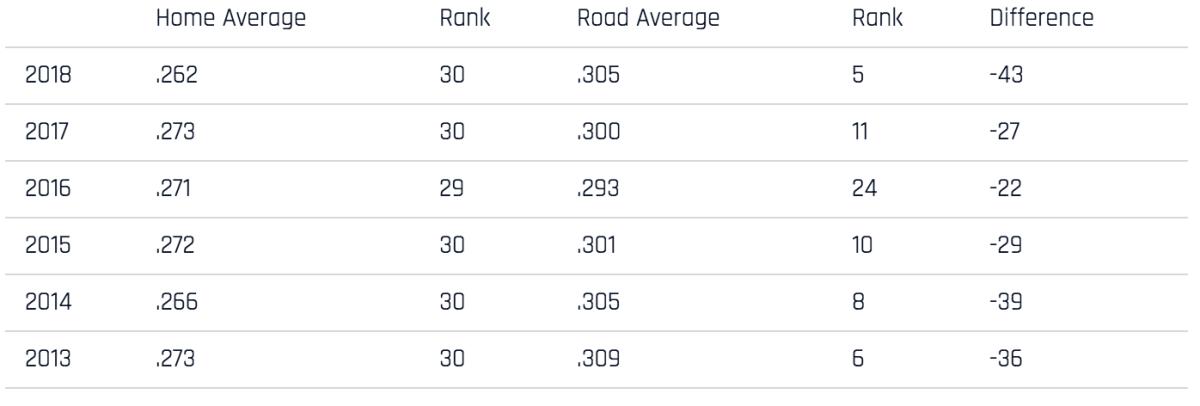
Here are six years worth of data regarding The Mystery of Flushing—so now we’re talking about something holding up over time and through personnel changes.
Mets' BABIP, 2013-18

The next worst home BABIP in that time isn’t even close to what the Mets have endured: .285 by Oakland.
The MLB average BABIP home/road split over those six years is +7 at home. The Mets are at -32. How does that translate into runs? It’s a similar story. The Mets are the seventh-highest scoring team in the league on the road but the worst in baseball at home.
Mets' Runs Scored, 2013-18

The average team over those six years enjoyed a 3% bump in run production when at home. The Mets were hit with a 17% decline at home.
The Mets opened Citi Field in 2009. They moved the outfield fences in twice since then, in 2012 and again, less drastically, in 2015. In their 10 seasons in the ballpark the Mets have posted six of the 13 lowest home BABIP marks in baseball. The rest of baseball has the other seven out of their combined 290 seasons.
Lowest Home BABIP Since 2009
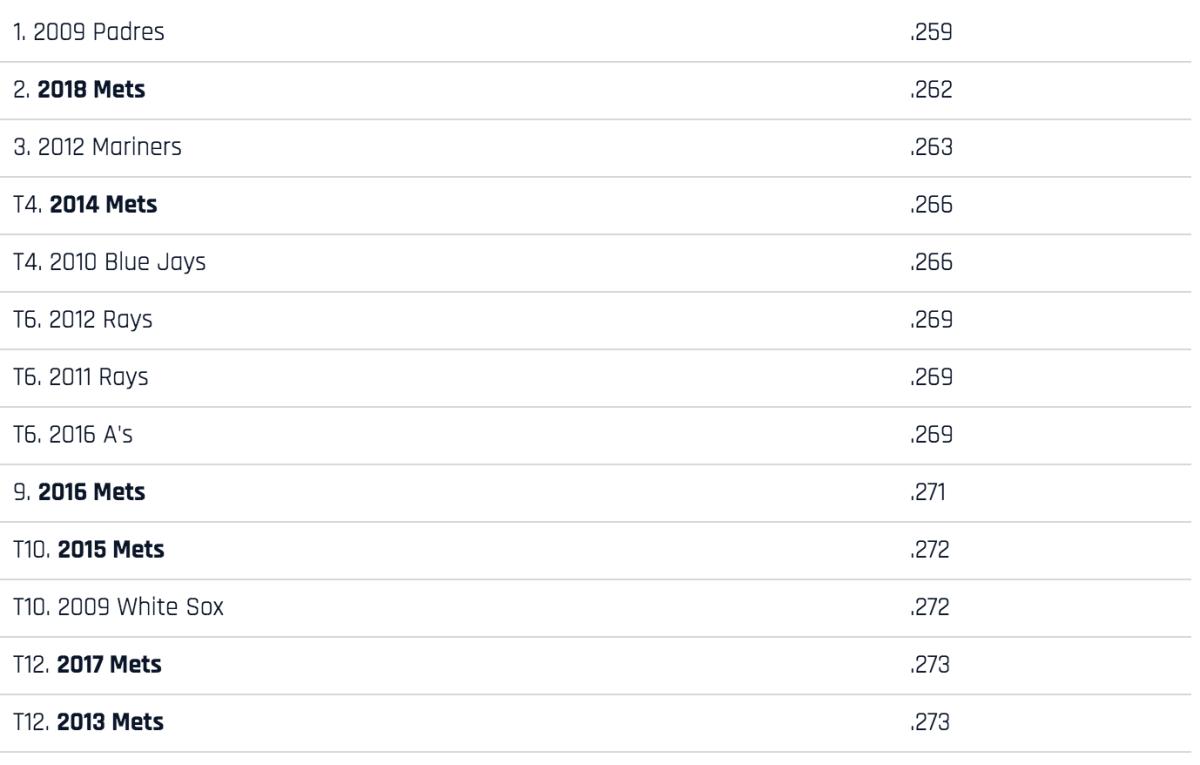
The problem is most apparent since 2013:
Lowest Home BABIP Since 2013
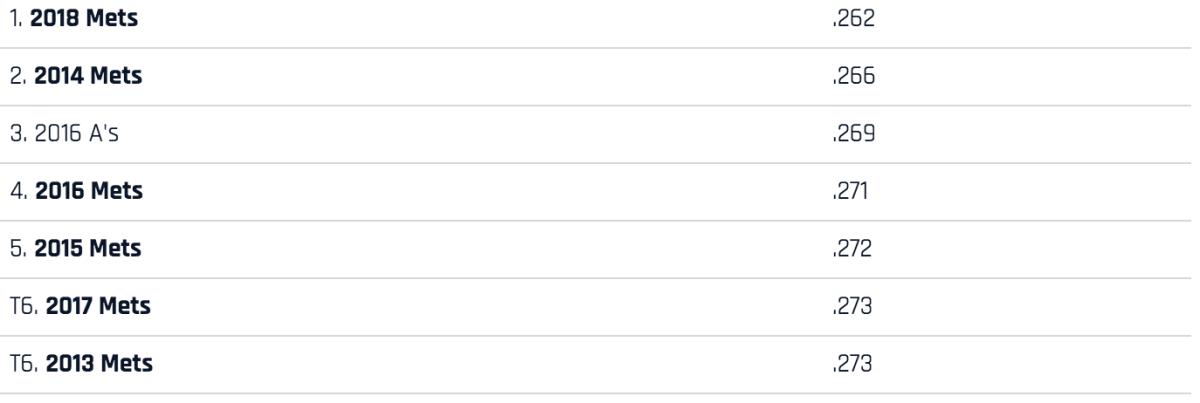
That pattern is staggering, if not downright mystifying. That’s why the Mets are looking into it.
“We don’t know why, but something is going on in this ballpark and the way we play here,” Roessler said at Citi Field recently. “We’re trying to find out. One thing I’ve heard is that the centerfielders will tell you sometimes they can feel the wind at their back, coming in from both sides of the [centerfield] scoreboard. But that’s just one anecdotal thing.”
The Mystery of Flushing also should cause the Mets to examine the kind of team they put in Citi Field. In general, New York in recent years has signed, traded for or developed an abundance of pull, flyball hitters without elite speed, especially from the left side. This year, for instance, Mets hitters have seen more shifts than any team in the National League. Overall, only the Angels, Rangers and Blue Jays—also-ran teams in the American League—face more shifts. The Mets also hit more pop-ups than any team in baseball, which are killers to BABIP.
But you would think such a profile would show up in BABIP on the road, too—rather than how the Mets morph into an elite hitting team away from Citi Field. The mystery is in the tremendous 43-point gap between balls falling for hits at home and on the road. The average major league team posts a .299 home BABIP and .294 on the road.
When you bake in the home runs and strikeouts and look purely at home batting average, this Mets team is among the worst all time when it comes to hitting at home. They rank among teams only from two of the Deadest Ball periods in the history of the game: before the ball was livened in 1920 and before the mound was lowered in 1969:
Worst Home Batting Average

Meanwhile, the Mystery of Flushing may help deGrom win the Cy Young Award. His numbers, especially the huge gap he owns in ERA (+0.61), make him the leading candidate in a very tight race with Aaron Nola of the Phillies and Max Scherzer of the Nationals. But with the Mystery of Flushing depressing his team’s offense, it’s worth considering that deGrom has thrown more stress pitches than any other pitcher not just this year, but also over the past four years.
The average major league pitcher throws 43.1 percent of his pitches with the go-ahead or tying run either at bat or on base. That means less than half the time the pitcher has to worry about his next pitch changing the leverage of the game. Now look at how often the leading NL Cy Young Award candidates pitch under that kind of stress:
Percent of Pitches With Go-Ahead or Tying Run at Bat or on Base

Nobody is close to the stress deGrom has faced. That 71.1% stress rate is the highest in baseball in at least four years—including higher than the league leader two years ago: deGrom. Here’s another way to look at it: examine the raw numbers of stress pitches, which show that deGrom has thrown the equivalent of about four more entire games under stress than Scherzer:
Stress Pitches, 2018

One more stress test. Because “pitching with the go-ahead or tying run at bat or on base” is a mouthful, I’ll simplify it to this question: how often did you throw a pitch when the score was tied or the difference was one run? For context purposes, the MLB average is 50.4%, or about half the time.
Batters Faced With Score Tied or Within One Run

Again, deGrom “wins” easily. He has faced 46 more batters in tight games than Nola and 138 more batters in tight games than Scherzer.
A cynic would suggest that deGrom pitched without stress because the Mets largely were out of the race by the All-Star break. Scherzer has pitched for a team that contended for almost five months and Nola still has the stress of a pennant race with which to deal.
Such thinking is more than a sloppy one-size-fits-all narrative, It is also an insult to any professional with a competitive bone in his body, no less deGrom, who attacks every pitch with enormous personal pride and organizational accountability. deGrom knows nothing of insouciance. To write off his season as the benefit of “pitches without consequence” demeans his professionalism.
I would argue that he pitched with tremendous stress, given his lack of run support, how well opposing pitchers pitched against him and the off-the-charts frequency of pitching with the game in the balance.
If this kind of “luck” holds, deGrom will have posted the greatest season in the history of the live ball era (since 1920) by a pitcher without a winning record. At 8-8. his 1.69 ERA blows away the 2.05 mark of tthe current “record holder,” Bob Veale, who went 13-14 for Pittsburgh in 1968, the anomalous Year of the Pitcher.
A 1.69 ERA? Throwing almost 80 percent of his pitches under stress? Enduring offensive support that is plagued by the Mystery of Flushing? That would be a Cy Young Award season.
SHOHEI OHTANI AND MICHAEL KOPECH ENSURE BASEBALL FANS AREN'T GOING TO STOP WORRYING ANYTIME SOON
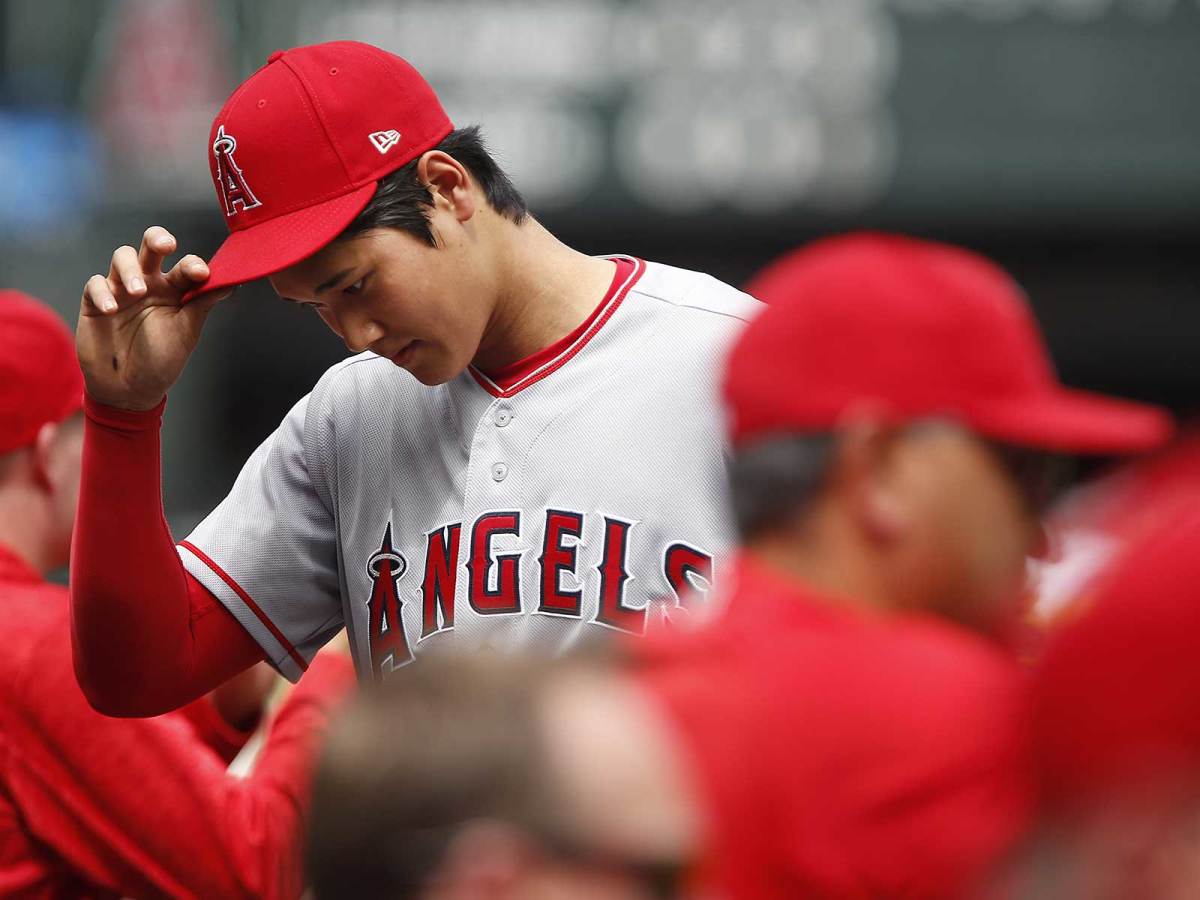
By Jack Dickey
One trait that distinguishes baseball’s fans from other sports’ is that we are constantly worried. Not just about the deficiencies of the teams we cheer for, which you’ll find everywhere, but about the deficiencies of other teams and the shortcomings of particular players and the sport’s problems appealing to younger audiences and everything under the sun, really. I have often wondered why, and I can’t say I’m getting any closer to an answer. But with certainty I can say we’d worry less if baseball didn’t give us so much to worry about.
The past week brought news that both Shohei Ohtani, the Angels’ 24-year-old two-way phenom, and Michael Kopech, the White Sox’s 22-year-old electrifying righty, would need Tommy John surgery to salvage their elbows. Neither, barring a miracle, will pitch next season. Ohtani—who hasn’t officially decided whether he’ll have the surgery—will at least be able to hit.
Growth of a New Game: Inside The Women's Baseball World Cup
Perhaps it was too much to ask for him to be the bigs’ first two-way player in nearly 100 years; perhaps something was bound to go wrong. And the injury worry had been there since last year for Ohtani. Word leaked out just days after he signed with the Angels that he had undergone platelet-rich plasma therapy on his pitching elbow in 2016.
Given, though, that Ohtani’s talents were better than advertised, and given that he's had no difficulty slicing up hitters (Khris Davis, Jose Altuve, Carlos Correa, and Robinson Cano went a combined 0-for-16 against him), it seems so cruel and frankly uncreative that what would befoul him was the same curse that struck hundreds of pitchers, special and ordinary, before him.
The same is true in Kopech’s case. His superlative stuff has wowed the baseball world since he hit 105 mph with his fastball in a start for the Salem Red Sox in September 2016. Even if eagle-eyed fans could have guessed at his trouble—his fastball averaged 97 mph in his big-league debut on Aug. 21 and was on average three ticks slower in his fourth-ever big-league start against Detroit on Wednesday—the news still landed as a gut punch. How was his exceptional arm as vulnerable as all the others?
Future Considerations: Why Ex-MLB Pitcher Michael Schwimer Is Investing in Minor League Longshots
I spent a good deal of time over the last few months talking about pitcher injuries with Michael Schwimer, a former big-leaguer who now runs a company that invests in minor leaguers. (My story on Schwimer and his company can be found here.) Schwimer contends that the company’s injury-prediction model, which analyzes video of pitchers’ windups for technical flaws, is the industry’s best, and the model, he says, has taught him that there’s almost no correlation between how hard a pitcher throws and how likely he is to get injured. Some of the sport’s hardest throwers—Max Scherzer, Justin Verlander, Chris Sale—have had long, healthy careers.
Still, there’s something amiss in the sport when the stars that burn the brightest go dark as often as top young pitchers do. Kopech and Ohtani weren’t likely to pitch in a meaningful game the rest of the season, and yet all of the baseball world worries not just for them but for anyone gifted and foolish enough to try his hand at pitching.
BEST THING I SAW: TREVOR STORY'S EPIC LASER SHOW AT COORS FIELD
By Gabriel Baumgaertner
Any baseball fan enjoys a player on a power surge. What Trevor Story did on Wednesday was less a power surge than Zeus’s thunderbolt … even if it took place in Colorado. Story should be a down-ballot MVP vote at the end of the season, and last Wednesday night was a good example of why he’s become one of the National League’s most feared hitters. Story hit 1,380 feet worth of homers in the Rockies’ 5–3 win over the Giants, giving Colorado a sweep and the lead in the NL West.
Each of the three homers Story hit were majestic in their own right.
The first of his homers went 459 feet despite him slipping in the box. Story took a 2-2 breaking ball from Andrew Suarez down the leftfield line with one of signature all-or-nothing swings that sent the ball flying to the hoards of fans frequenting the dining concourse.
The second was the most majestic home run of the night and possibly of the Statcast era. Story’s 505-foot dinger almost cleared that same concourse. It was the longest homer that MLB recorded since 2015 and one of the most gorgeous parabolas you’ll find over the last decade. Of the 31 homers that Story has hit this year, it’s bound to be the one that the baseball-watching public will remember.
The third was a line drive that traveled 416 feet and one that threatened to decapitate anyone who got in its way. The 22-degree launch angle was clearly the lowest of the night, but the ball was, for lack of a better term, smoked.
It was the finest trio of homers you’ll find this season, and Story’s breakout season is one of the best stories of the year.
ROUNDTABLE: WHO HAS BEEN THE BEST AND WORST MIDSEASON ACQUISITION?
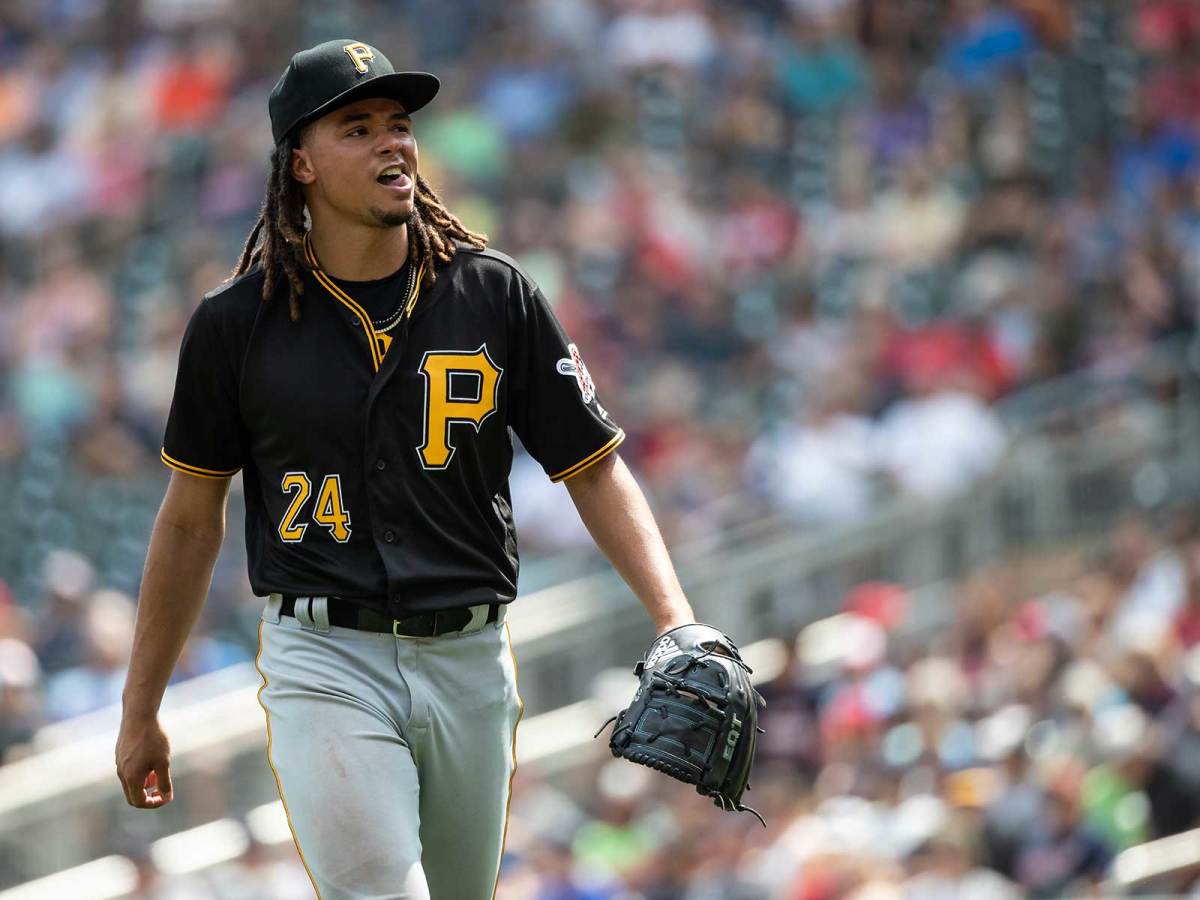
Emma Baccellieri: Cole Hamels stands out as the best. That’s from his own success, of course—his 4.72 ERA and 5.19 FIP pre-trade have dropped to 1.42 and 2.70 post-trade, and while the long ball was a huge problem for him in Texas, he’s given up just one home run in his eight games with Chicago. But it’s also because starting pitching has been such an area of need for the Cubs, as the team’s one clear weakness while they push toward the postseason. Hamels’ presence hasn’t quite fixed their rotation woes, but there’s nowhere else that a single player could have made such a dramatic impact for them.
As for the worst? The Pirates were trading for more than just one half-season of Chris Archer, but man, this half-season really hasn’t been a good look so far. (The fact that the team gave up such a hefty package to acquire him doesn’t help.) He’d already been struggling this season, and he’s taken a step back in almost every way since being traded. His ERA has spiked above the 5.00-mark; his strikeouts are down, and his walks are up. It’s certainly not on him that Pittsburgh has fallen out of the race after a 10-17 August record—but he didn’t do much to help there, either.
Jack Dickey: Is it possible that the best trade deadline acquisition was Kevin Gausman? Since coming to Atlanta, the inconsistent Orioles starter (maybe redundant) has turned into Greg Maddux, with a 2.32 ERA in seven starts. He may yet turn into a pumpkin—his FIP is almost a run and a half higher than that ERA—but the Braves have already gotten a lot out of him. Worst? I’ll stick in Atlanta: Adam Duvall. Duvall has hit .095/.156/.095 in 45 plate appearances since coming over from Cincinnati. Atlanta would have been better off had they given the playing time to Julio Teheran, who’s mashing, by comparison, at .194/.211/.278. The Braves have wised up and haven’t given Duvall a start in two weeks, but considering they dealt three players for him alone, they have to feel like they lost out.
Indians' José Ramírez Becomes First Member of 30-30 Club Since 2012
Connor Grossman: J.A. Happ has been a badly needed jolt to the Yankees' pitching staff. While first-half ace Luis Severino has wilted over his last 10 starts (sporting an ERA just below seven), Happ has been so solid in his seven outings with New York that he may very well start the AL Wild Card game. The Yankees have won six of his seven starts while Happ has posted a 3.10 ERA and finished six innings in five of seven games since leaving the Blue Jays. As for the worst acquisition, I'll have to borrow Jack Dickey's selection from above. Adam Duvall has been abysmal in Atlanta. It stands to wonder whether he'll make the postseason roster.
Jon Tayler: Cole Hamels has been a godsend for the Cubs, with a 1.42 ERA and 48 strikeouts in 50 2/3 innings to save a rotation that was perilously thin before his arrival. I want to throw some love, though, toward righthanded reliever Ryan Pressly, a smart low-cost pickup by the Astros from the Twins. In 16 2/3 innings with Houston, Pressly has a 1.08 ERA and 23 strikeouts against just one walk. He’s a true late-inning weapon that’s deepened a tough bullpen.
On the other side of the ledger, the Brewers’ two high-profile moves haven’t panned out. Mike Moustakas has just a 107 OPS+ in 35 games, and Jonathan Schoop has hit a brutal .216/.263/.352 since joining Milwaukee. Both those trades felt like a curious allocation of resources at the time and don’t look much better now. Speaking of NL Central mistakes: Pittsburgh’s Chris Archer deal looks like a blunder. He has a 5.24 ERA and 13 walks in 34 1/3 innings with the Pirates, who predictably fell out of the wild-card race post-deadline, while Tyler Glasnow and Austin Meadows look like future building blocks for Tampa. That risky gamble on the Bucs’ part hasn’t paid off.
What Happened to the Nationals? How Did One of Baseball’s Best Teams Fall So Far?
Tom Verducci: The best midseason acquisition is Cole Hamels by the Cubs. Hamels (4-0, 1.42) has been a staff saver while three big free agent acquisitions—Yu Darvish, Tyler Chatwood and Brandon Morrow—have been hurt and/or ineffective. Hamels has benefited from getting out of the Rangers' ballpark, where his ERA was 6.41; getting out of the AL; seeing his velocity come back, and ditching low two-seamers for more high four-seamers.
The worst acquisition was Roberto Osuna by the Astros. It’s not that he entered tie games three times and lost two of them and never pitches more than three outs. He has thrown the ball well overall and fills up the strike zone. It’s just that his May 8 arrest by Toronto police for assaulting a woman—and his acceptance of a 75-game by MLB—hangs over this club and won’t go away under the national spotlight of postseason baseball. A fan was recently kicked out of the ballpark for holding a sign with Houston’s domestic violence hot line. Osuna’s next hearing in the case is Sept. 19.
NOT ALL REBUILDS ARE CREATED EQUAL, JUST ASK THE WHITE SOX
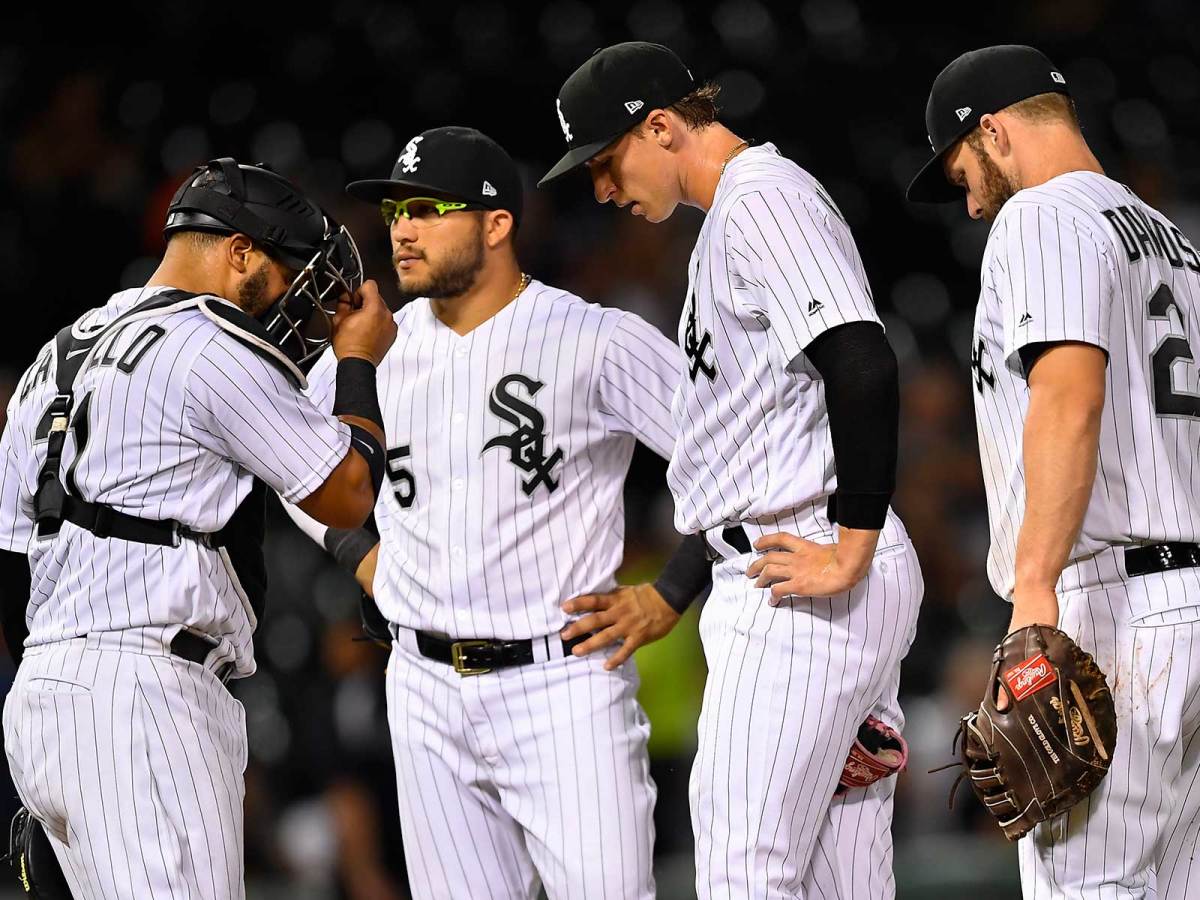
By Emma Baccellieri
In retrospect, it feels strange that the predominant preseason feeling around the Chicago White Sox was hope—or, at least, something like it. But any sense of hope said more about fans’ standards than about the team itself.
There was no hope for winning, now a decade removed from their last trip to the postseason. There was only hope for the next step in the process that should lead to winning. And that hope looked not only reasonable, but almost self-evident! Yoan Moncada could easily put all the pieces together in what would be his first full big-league season. Reynaldo Lopez’s 2017 improvements could be seen as a foundation for 2018 success. Lucas Giolito just might remind everyone why he’d been a consensus top prospect; Carson Fulmer could do the same, if you were really optimistic. Meanwhile, Carlos Rodon would have to spend the beginning of the year on the disabled list, but his slider was still as captivating as ever, and it didn’t take too much magical thinking to imagine him as a triumph.
That was just the young talent already at the major-league level. Flamethrower Michael Kopech should be up soon; so, too, would outfield phenom Eloy Jimenez. If you preferred to take the long view, well, there was plenty more in the pipeline to focus on beyond this season. Cuban Luis Robert didn’t have much of an international track record, but the team clearly believed in the young outfielder, as they’d been willing to invest $26 million to sign him last year. Jake Burger’s power at third base sounded like it could be prodigious. Dane Dunning might end up making a move to the bullpen, but that didn’t necessarily erase his status as a promising pitching prospect. All of the above could be up for 2019. The White Sox’s immediate future didn’t hold winning, no. But it was supposed to, at the least, have some fun.
The Shame of MLB's Anti-Labor, Anti-Competitive "Service Time" Rules
So… what’s the current status of that spring hope? Kopech’s Tommy John surgery, which was announced last week and will keep him out for all of next season, seems like a good metaphor. Some might want to go with the fact that Giolito’s toughest competition for the title of “worst starting pitcher in baseball” would be Fulmer, if only the latter hadn’t been pushed down to the minors. But that’s a bit too extreme. Chicago’s rebuild isn’t doomed, nor has it necessarily depreciated. It’s just more difficult to see the contours of a successful path—especially if you’re looking for one that begins next year, rather than in 2020 or 2021. All of the available major league talent has struggled, from Moncada’s below-average performance at the plate to Lopez’s spiked walk rate. Much of the most promising minor league talent has gotten hurt, from Burger’s Achilles tear (not once, but twice) to Dunning’s sprained elbow. And Jimenez, the most promising talent of all, is in a category of his own. He’s neither struggled nor has he been hurt. Instead, he’s excelled, and as a result, he’s been held down for what reeks of service-time manipulation.
A team can stockpile all the talent in the world—but there are still any number of ways for a rebuilding project to get delayed, and this season has given the White Sox some hands-on experience with just about all of them. Not every rebuild can produce the surprising magic of the Astros and Cubs in 2015 or even this year's teams in Atlanta and Philadelphia.
WHAT'S ON TAP: ALEX BREGMAN CONTINUES TO POWER THE ASTROS
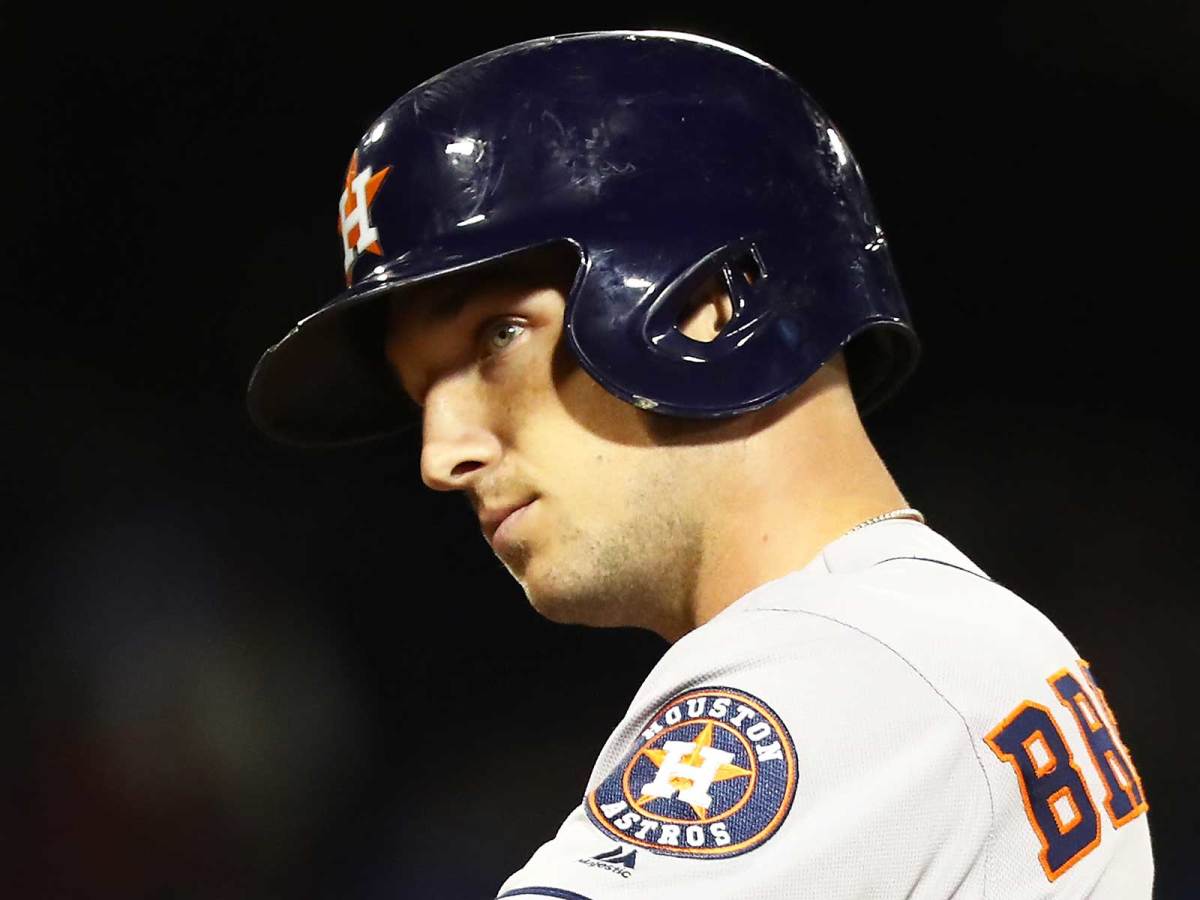
By Michael Beller
Hitter to Watch: Alex Bregman, Astros
Bregman has homered on more days in September than he hasn’t, leaving the yard in five of Houston’s eight games. He’s 13-for-29 with five homers and 11 RBIs in that time, helping the Astros win eight straight games. The last three of those came against the Red Sox in what could be a preview of the ALCS. Bregman has taken a full superstar turn this year, hitting .299/.401/.563 with 30 homers, 49 doubles and 97 RBI, and more walks (84) than strikeouts (73).
Pitcher to Watch: Corey Kluber, Indians
The Royals knocked Kluber around a couple weeks ago, tagging him for five runs on nine hits in 5 1/3 innings. Kluber got revenge in his last trip to the mound, striking out 10 while allowing one run on two hits in 6 2/3 innings. Kluber’s having his quietest All-Star season, pitching to a 2.75 ERA and 0.95 WHIP with 190 strikeouts in 193 1/3 innings. He’ll make two starts this week, facing the Rays on Monday and Tigers over the weekend.
Series to Watch: Brewers at Cubs, Monday through Wednesday
The Brewers have won nine of their last 11 games, cutting the Cubs lead in the NL Central to two games. This is the last chance they’ll have to trim the lead in direct competition, with these three games the final meetings between these two teams in the regular season. The Cubs have won 10 of the 16 games between the two this year, which basically marks the difference between first place and second place. The Brewers will send Wade Miley, Jhoulys Chacin and Chase Anderson to the mound in this series, while the Cubs will counter with Jon Lester, Jose Quintana and Kyle Hendricks.
100 WORDS ON THE A'S ASCENSION
By Connor Grossman
Take a moment to appreciate the A’s. Sunday’s win nudged the team to 30 over .500. They’re only a handful of games behind the defending champion Astros in the AL West and the Yankees in the AL Wild Card race. No team has won more games since the All-Star break than Oakland. How, you ask? Since the break, the A’s lead the American League in OPS, homers (tied), extra-base hits, ERA, batting average against and WHIP. They’re a well-rounded bunch that’s smashed anyone’s reasonable expectation for how this season might play out. Sign me up for a deep October run.
TWEETS OF THE WEEK
Yankees Most HR at Age 21 or Younger (Single Season)
— James Smyth (@JamesSmyth621) September 8, 2018
29 Joe DiMaggio 1936 (21 yrs)
23 Gleyber Torres 2018 (21 yrs)
23 Mickey Mantle 1952 (20 yrs)
21 Mickey Mantle 1953 (21 yrs)
13 Mickey Mantle 1951 (19 yrs)
#SFGiants Barry Bonds hit 154 home runs to just 153 strikeouts over the span of 442 games from Aug. 14, 2001 to Sept. 7, 2004.
— Ryan M. Spaeder (@theaceofspaeder) September 7, 2018
Squirrels and Salsa. We're pulling out of all of the stops this season! 🔥 https://t.co/iBV3EGYS23
— St. Louis Cardinals (@Cardinals) September 9, 2018
— out of context baseball (@baseballcontext) September 8, 2018
For anyone who wants to know what’s happening with my ❤️. 👇🏾 https://t.co/iXZDGTp20q
— Kenley Jansen (@kenleyjansen74) September 9, 2018
FROM THE VAULT: PETE ROSE BECOMES BASEBALL'S HIT KING
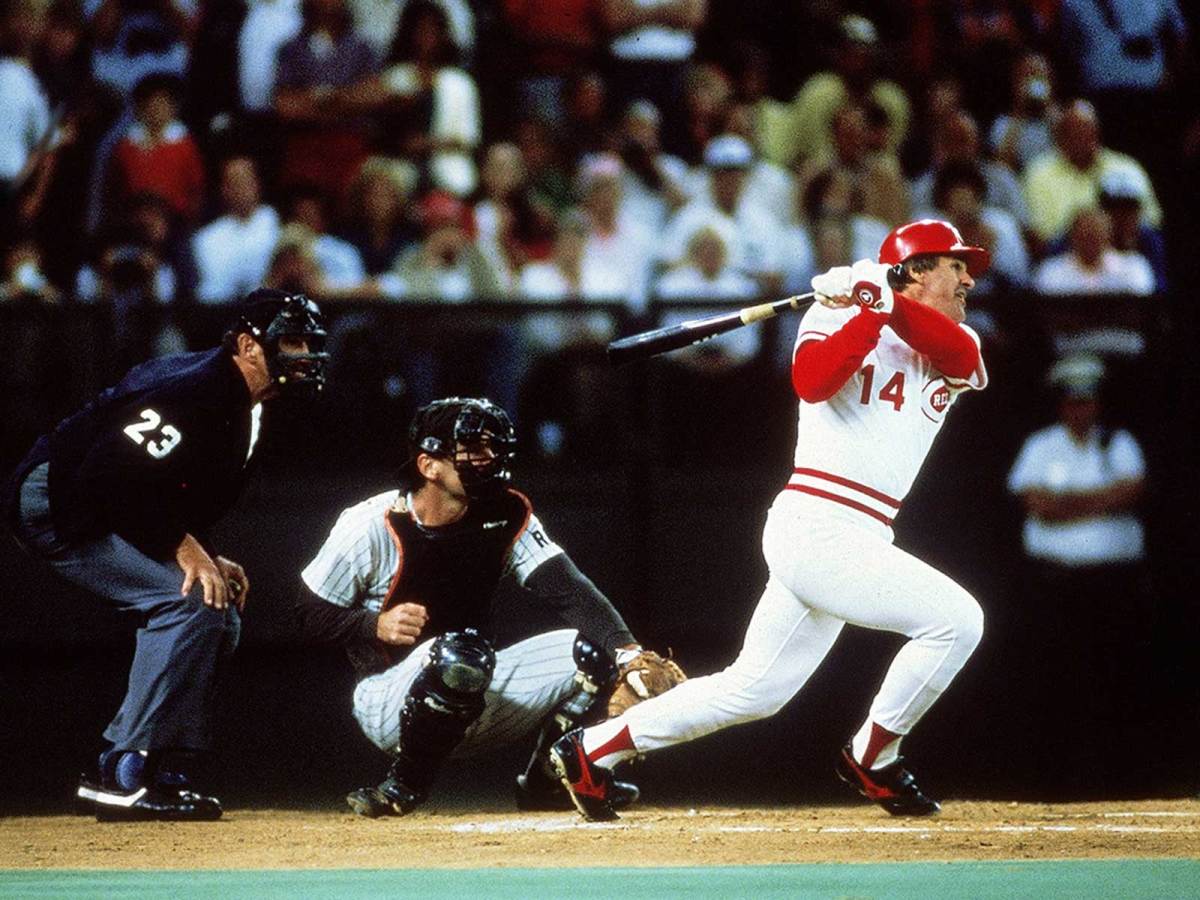
By Connor Grossman
Pete Rose's legacy has been colored much differently than we imagined it would back in September 1985. Thirty-three years ago Rose completed his trek toward history, passing Ty Cobb for the most hits in baseball history. At the time, Rose's place in Cooperstown was all but assured. Now he's banned permanently from any formal association with MLB and it's doubtful the anniversary of Rose collecting hit No. 4,192 will be widely acknowledged on Tuesday. A lot can change in three-plus decades.
SI's Craig Neff was in Cincinnati to document Rose's date with history at the time, starting with the bizarre circumstances that occurred in the game Rose tied Cobb's record.
Enjoy the excerpt below and find the entire story here.
On Sunday the big news was Rose's decision to play. Two hits shy of Cobb, the Cincinnati player-manager had planned to yield his first base duties to the younger (43) Tony Perez for the day because Chicago was starting lefthander Steve Trout.
But late Sunday morning the Cubs announced that Trout had skidded on a patch of gravel while riding his bicycle the previous evening and had fallen onto his left shoulder. Reggie Patterson, a young junk-balling righthander called up from the minor leagues just five days earlier, would start in his place. Faster than you could say deus ex machina, Rose was back in the Reds lineup.
